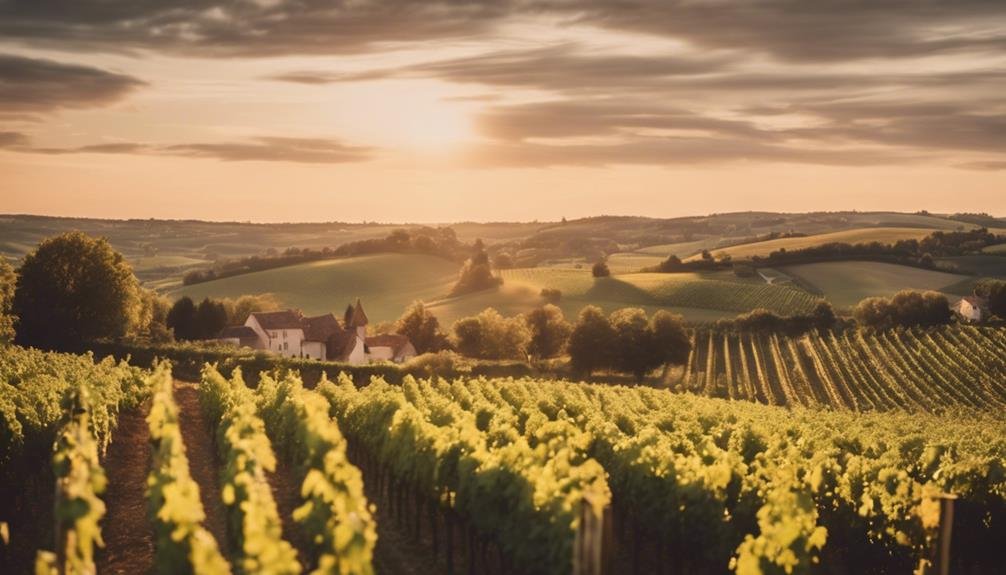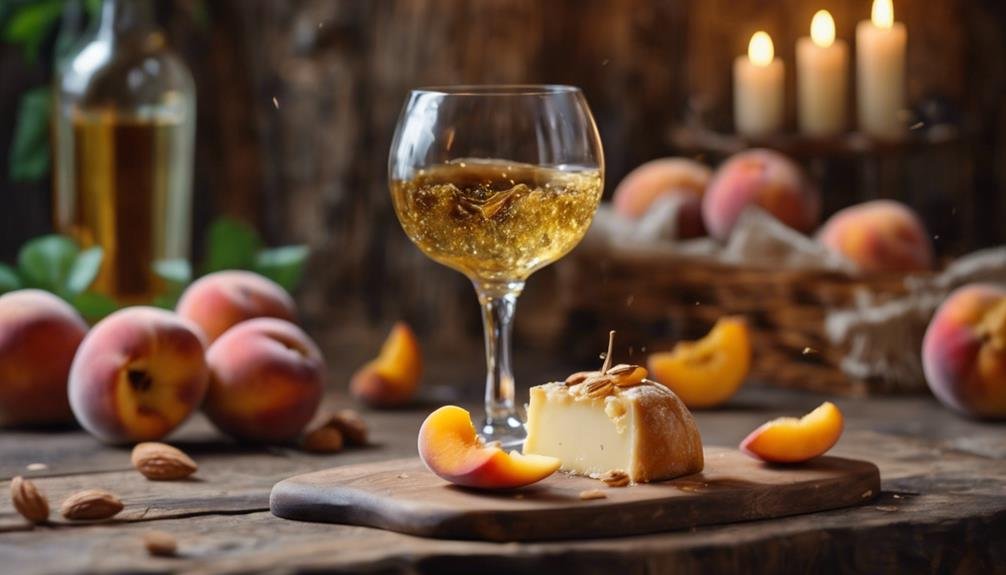Discover the exquisite Sauternes wine, crafted from a trio of Sémillon, Sauvignon Blanc, and Muscadelle grapes. Known for its late-harvest style with honeyed apricot and butterscotch notes, this wine offers 120–220 g/L of residual sugar. Ideal for pairing with decadent desserts, it delivers a luxurious and unforgettable experience. The blend's sweetness from Sémillon, acidity from Sauvignon Blanc, and floral notes from Muscadelle create a luscious and complex flavor profile. Sauternes, enriched by Noble Rot, Botrytis cinerea, balances sweet and acidic notes perfectly, enhancing sweet and savory dishes. Uncover the secrets of the Sauternais terroir for a deeper appreciation.
Sauternes: A Sweet Wine Revelation
In the world of sweet wines, Sauternes stands out as a delightful revelation, showcasing a harmonious blend of Sémillon, Sauvignon Blanc, and Muscadelle grapes from the Graves region in Bordeaux, France.
This golden nectar offers a sweet indulgence that fulfills dessert dreams with its rich flavors and luscious texture. Sauternes, known for its full-bodied and late-harvest style, captivates wine enthusiasts with intense notes of honeyed apricot, butterscotch, and tropical fruit, accompanied by hints of marmalade and toasted spices.
With around 120–220 g/L of residual sugar, this wine strikes a perfect balance between sweetness and acidity, making it a perfect pairing for a variety of decadent desserts or as a standalone treat.
Sauternes truly embodies the art of crafting a luxurious and unforgettable wine experience.
Grape Trio: Sémillon, Sauvignon Blanc, Muscadelle
The trio of Sémillon, Sauvignon Blanc, and Muscadelle grapes forms the foundation of the renowned Sauternes wine, collectively contributing distinct characteristics to its luscious and complex flavor profile. Sémillon brings a vital sweetness essential for the wine's richness, while Sauvignon Blanc adds a balancing acidity to complement the sweetness.
Muscadelle, on the other hand, imparts floral notes that enhance the aromatic complexity of the blend. The synergy between these three grape varieties is essential in creating the unique taste profile that defines Sauternes wine. Sémillon's sweetness, combined with Sauvignon Blanc's acidity and Muscadelle's florals, harmoniously come together to produce a decadent and unforgettable wine experience.
Sauternes Flavorful Symphony

Crafting a harmonious blend of intense flavors, Sauternes wine showcases a symphony of honeyed apricot, butterscotch, and tropical fruit notes.
- Noble Rot Exploration: The unique noble rot, Botrytis cinerea, contributes to the rich sweetness and complex flavors of Sauternes.
- Dessert Wine Wonders: Sauternes stands out as a luscious dessert wine, perfect for indulging in after a meal or pairing with sweet treats.
- Flavorful Harmony: The balance of sweet and acidity in Sauternes creates a delightful harmony on the palate, making it a versatile wine.
- Culinary Adventures: Sauternes opens up a world of culinary adventures, enhancing the flavors of both sweet and savory dishes.
- Sensory Delight: Each sip of Sauternes offers a sensorial experience, with layers of flavors that evolve on the taste buds, leaving a lasting impression.
Sauternes: Perfect Pairings
Sauternes wine's versatility extends beyond traditional dessert pairings, offering a spectrum of perfect culinary companions that elevate both sweet and savory dishes.
When it comes to dessert wonders, Sauternes shines alongside classics like almond tart, lemon tart, or custards, enhancing their flavors with its honeyed richness.
But there are also savory surprises awaiting those who explore beyond the expected. Pair this luscious wine with Roquefort or Livarot cheese for a delightful contrast, or elevate your meal with foie gras or herb-roasted poultry.
For those craving a touch of adventure, try matching it with spicy Asian dishes, where the wine's sweetness can tame the heat while complementing the complex flavors. Sauternes truly offers a world of culinary possibilities beyond the domain of traditional desserts.
Unveiling the Sauternais Terroir

Nestled within the Graves region of Bordeaux, France, the Sauternais terroir reveals a mesmerizing landscape of chalky, gravelly soils near the Garonne River, fostering the unique microclimate that shapes the renowned Sauternes wines.
- Exploring vineyards: Vineyards in Sauternes offer a glimpse into the meticulous care required to produce these exceptional wines.
- Terroir secrets: The terroir's secrets lie in its perfect combination of soil, climate, and topography.
- Climate influence: The microclimate, influenced by the nearby river, creates the ideal conditions for noble rot development.
- Soil composition: Chalky and gravelly soils contribute to the minerality and complexity found in Sauternes wines.
- Historical significance: The terroir's history and heritage play an essential role in shaping the identity of Sauternes wines.
Frequently Asked Questions
How Did the Accidental Discovery of Noble Rot Impact Sauternes Production?
The accidental discovery of noble rot, caused by Botrytis cinerea, revolutionized Sauternes production. This natural mold desiccates grapes, concentrating sugars and flavors. Winemaking techniques embrace this phenomenon, leading to the creation of lusciously sweet and complex Sauternes wines.
What Is the Significance of the Grape Trio in Sauternes Wine?
The grape trio in Sauternes wine, consisting of Sémillon, Sauvignon Blanc, and Muscadelle, plays an essential role in the winemaking process. Sémillon's susceptibility to noble rot, Sauvignon Blanc's acidity, and Muscadelle's floral character create a harmonious blend.
Why Are Sauternes Wines Often Recommended With Specific Dessert Pairings?
Sauternes wines are recommended with specific dessert pairings due to their intense sweetness and complex flavor profile. The rich, fruity notes of Sauternes complement desserts like blue cheese, foie gras, and fruit-themed delicacies, creating harmonious culinary experiences.
What Sets Barsac Wines Apart From Sauternes in Terms of Flavor and Style?
Barsac wines distinguish themselves from Sauternes with a lighter, fresher profile due to their sweeter style. These wines originate from the neighboring sub-region in Graves, Bordeaux, known for unique microclimates and vineyards on chalky, gravelly soils near the Garonne River.
What Historical Events Contributed to the Rise of Sauternes Wines in the 1800s?
The rise of Sauternes wines in the 1800s was influenced by historical events like the French Revolution and the Industrial Revolution. These periods brought about changes in land ownership, trade networks, and winemaking techniques, leading to the prosperity of Sauternes production.
Conclusion
To sum up, the exquisite Sauternes wine is not merely a drink; it is a symphony of flavors that dances on the palate with unparalleled grace and sophistication.
From the harmonious blend of Sémillon, Sauvignon Blanc, and Muscadelle grapes to the rich history and terroir of the Graves region, Sauternes stands as a tribute to the artistry and dedication of winemakers.
Indulge in a glass of Sauternes, and experience a taste of decadence like no other.
Cheers to the opulent world of fine wines!
